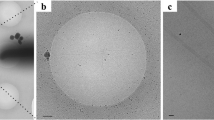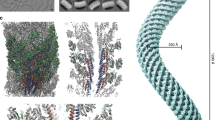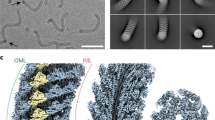Abstract
The bacterial flagellar filament is a helical propeller rotated by the flagellar motor for bacterial locomotion. The filament is a supercoiled assembly of a single protein, flagellin, and is formed by 11 protofilaments. For bacterial taxis, the reversal of motor rotation switches the supercoil between left- and right-handed, both of which arise from combinations of two distinct conformations and packing interactions of the L-type and R-type protofilaments. Here we report an atomic model of the L-type straight filament by electron cryomicroscopy and helical image analysis. Comparison with the R-type structure shows interesting features: an orientation change of the outer core domains (D1) against the inner core domains (D0) showing almost invariant orientation and packing, a conformational switching within domain D1, and the conformational flexibility of domains D0 and D1 with their spoke-like connection for tight molecular packing.
This is a preview of subscription content, access via your institution
Access options
Subscribe to this journal
Receive 12 print issues and online access
$189.00 per year
only $15.75 per issue
Buy this article
- Purchase on Springer Link
- Instant access to full article PDF
Prices may be subject to local taxes which are calculated during checkout




Similar content being viewed by others
References
Berg, H.C. & Anderson, R.A. Bacteria swim by rotating their flagellar filaments. Nature 245, 380–382 (1973).
Silverman, M. & Simon, M. Flagellar rotation and the mechanism of bacterial motility. Nature 249, 73–74 (1974).
Kudo, S., Magariyama, Y. & Aizawa, S.-I. Abrupt changes in flagellar rotation observed by laser darkfield microscopy. Nature 346, 677–680 (1990).
Ryu, W.S., Berry, R.M. & Berg, H.C. Torque-generating units of the flagellar motor of Escherichia coli have a high duty ratio. Nature 403, 444–447 (2000).
O'Brien, E.J. & Bennett, P.M. Structure of straight flagella from a mutant Salmonella. J. Mol. Biol. 70, 133–152 (1972).
Galkin, V.E. et al. Divergence of quaternary structures among bacterial flagellar filaments. Science 320, 382–385 (2008).
Asakura, S. Polymerization of flagellin and polymorphism of flagella. Adv. Biophys. 1, 99–155 (1970).
Larsen, S.H., Reader, R.W., Kort, E.N., Tso, W.W. & Adler, J. Change in direction of flagellar rotation is the basis of the chemotactic response in Escherichia coli. Nature 249, 74–77 (1974).
Macnab, R.M. & Ornston, M.K. Normal-to-curly flagellar transitions and their role in bacterial tumbling. Stabilization of an alternative quaternary structure by mechanical force. J. Mol. Biol. 112, 1–30 (1977).
Turner, L., Ryu, W.S. & Berg, H.C. Real-time imaging of fluorescent flagellar filaments. J. Bacteriol. 182, 2793–2801 (2000).
Kamiya, R. & Asakura, S. Helical transformations of Salmonella flagella in vitro. J. Mol. Biol. 106, 167–186 (1976).
Kamiya, R. & Asakura, S. Flagellar transformations at alkaline pH. J. Mol. Biol. 108, 513–518 (1977).
Kamiya, R., Asakura, S., Wakabayashi, K. & Namba, K. Transition of bacterial flagella from helical to straight forms with different subunit arrangements. J. Mol. Biol. 131, 725–742 (1979).
Calladine, C.R. Construction of bacterial flagella. Nature 225, 121–124 (1975).
Calladine, C.R. Design requirements for the construction of bacterial flagella. J. Theor. Biol. 57, 469–489 (1976).
Calladine, C.R. Change of waveform in bacterial flagella: the role of mechanics at the molecular level. J. Mol. Biol. 118, 457–479 (1978).
Hyman, H.C. & Trachtenberg, S. Point mutations that lock Salmonella typhimurium flagellar filaments in the straight right-handed and left-handed forms and their relation to filament superhelicity. J. Mol. Biol. 220, 79–88 (1991).
Kanto, S., Okino, H., Aizawa, S.-I. & Yamaguchi, S. Amino acids responsible for flagellar shape are distributed in terminal regions of flagellin. J. Mol. Biol. 219, 471–480 (1991).
Kamiya, R., Asakura, S. & Yamaguchi, S. Formation of helical filaments by copolymerization of two types of 'straight' flagellins. Nature 286, 628–630 (1980).
Mimori, Y. et al. The structure of the R-type straight flagellar filament of Salmonella at 9 Å resolution by electron cryomicroscopy. J. Mol. Biol. 249, 69–87 (1995).
Morgan, D.G., Owen, C., Melanson, L.A. & DeRosier, D.J. Structure of bacterial flagellar filaments at 11 Å resolution: packing of the α-helices. J. Mol. Biol. 249, 88–110 (1995).
Mimori-Kiyosue, Y., Vonderviszt, F., Yamashita, I., Fujiyoshi, Y. & Namba, K. Direct interaction of flagellin termini essential for polymorphic ability of flagellar filament. Proc. Natl. Acad. Sci. USA 93, 15108–15113 (1996).
Mimori-Kiyosue, Y., Vonderviszt, F. & Namba, K. Locations of terminal segments of flagellin in the filament structure and their roles in polymorphism and polymerization. J. Mol. Biol. 270, 222–237 (1997).
Vonderviszt, F., Aizawa, S.-I. & Namba, K. Role of the disordered terminal regions of flagellin in filament formation and stability. J. Mol. Biol. 221, 1461–1474 (1991).
Yamashita, I. et al. Structure and switching of bacterial flagellar filament studied by X-ray fiber diffraction. Nat. Struct. Biol. 5, 125–132 (1998).
Hasegawa, K., Yamashita, I. & Namba, K. Quasi- and nonequivalence in the structure of bacterial flagellar filament. Biophys. J. 74, 569–575 (1998).
Yonekura, K., Maki-Yonekura, S. & Namba, K. Complete atomic model of the bacterial flagellar filament by electron cryomicroscopy. Nature 424, 643–650 (2003).
Samatey, F.A. et al. Structure of the bacterial flagellar protofilament and implications for a switch for supercoiling. Nature 410, 331–337 (2001).
Kitao, A. et al. Switch interactions control energy frustration and multiple flagellar filament structures. Proc. Natl. Acad. Sci. USA 103, 4894–4899 (2006).
Namba, K. & Vonderviszt, F. Molecular architecture of bacterial flagellum. Q. Rev. Biophys. 30, 1–65 (1997).
Yonekura, K., Maki-Yonekura, S. & Namba, K. Building the atomic model for the bacterial flagellar filament by electron cryomicroscopy and image analysis. Structure 13, 407–412 (2005).
Yonekura, K., Toyoshima, C., Maki-Yonekura, S. & Namba, K. GUI programs for processing individual images in early stages of helical image reconstruction—for high-resolution structure analysis. J. Struct. Biol. 144, 184–194 (2003).
Yonekura, K. & Toyoshima, C. Structure determination of tubular crystals of membrane proteins. IV. Distortion correction and its combined application with real-space averaging and solvent flattening. Ultramicroscopy 107, 1141–1158 (2007).
Yonekura, K. & Toyoshima, C. Structure determination of tubular crystals of membrane proteins. III. Solvent flattening. Ultramicroscopy 84, 29–45 (2000).
Wakabayashi, T., Huxley, H.E., Amos, L.A. & Klug, A. Three-dimensional image reconstruction of actin-tropomyosin complex and actin-tropomyosin-troponin T-troponin I complex. J. Mol. Biol. 93, 477–497 (1975).
Yonekura, K. & Toyoshima, C. Structure determination of tubular crystals of membrane proteins. II. Averaging of tubular crystals of different helical classes. Ultramicroscopy 84, 15–28 (2000).
Jones, T.A., Zhou, J.Y., Cowan, S.W. & Kjeldgaard, M. Improved methods for building protein models in electron density maps and the location of errors in these models. Acta Crystallogr. A 47, 110–119 (1991).
Wang, H. & Stubbs, G. Molecular dynamics in refinement against fiber diffraction data. Acta Crystallogr. A 49, 504–513 (1993).
Laskowski, R.A., MacArthur, M.W., Moss, D.S. & Thornton, J.M. PROCHECK: a program to check the stereochemistry of protein structures. J. Appl. Crystallogr. 26, 283–291 (1993).
Kraulis, P.J. MOLSCRIPT: a program to produce both detailed and schematic plots of protein structures. J. Appl. Crystallogr. 24, 946–950 (1991).
Merritt, E.A. & Bacon, D.J. Raster3D: Photorealistic molecular graphics. Methods Enzymol. 277, 505–524 (1997).
Pettersen, E.F. et al. UCSF Chimera - a visualization system for exploratory research and analysis. J. Comput. Chem. 25, 1605–1612 (2004).
Acknowledgements
We thank C. Toyoshima for part of the helical image reconstruction programs, D.A. Agard and J.W. Sedat for support to S.M.-Y. and K.Y. and F. Oosawa, S. Asakura and D.L.D. Caspar for continuous support and encouragement. This work was partly supported by funds from the W.M. Keck Advanced Microscopy Laboratory at the University of California, San Francisco, to K.Y. and by Grants-in-Aid for Scientific Research (16087207) 'National Project on Protein Structural and Functional Analyses' from the Ministry of Education, Science and Culture of Japan to K.N.
Author information
Authors and Affiliations
Contributions
S.M.-Y. prepared filament samples, collected electron cryomicroscopy images, analyzed images and carried out model building; K.Y. developed programs for graphical user interface, spline fitting and superimposition of the molecular models of the L- and R-type filaments; K.Y. also supervised all the computational analysis; S.M.-Y., K.Y. and K.N. wrote the paper.
Corresponding authors
Ethics declarations
Competing interests
The authors declare no competing financial interests.
Supplementary information
Supplementary Text and Figures
Supplementary Figures 1 and 2, Supplementary Tables 1–3 (PDF 1614 kb)
Supplementary Movie 1
Transition between the L-type and R-type straight filaments in stereo (MOV 763 kb)
Rights and permissions
About this article
Cite this article
Maki-Yonekura, S., Yonekura, K. & Namba, K. Conformational change of flagellin for polymorphic supercoiling of the flagellar filament. Nat Struct Mol Biol 17, 417–422 (2010). https://doi.org/10.1038/nsmb.1774
Received:
Accepted:
Published:
Issue Date:
DOI: https://doi.org/10.1038/nsmb.1774
This article is cited by
-
Different serotypes of Escherichia coli flagellin exert identical adjuvant effects
BMC Veterinary Research (2022)
-
The cryo-EM structure of the bacterial flagellum cap complex suggests a molecular mechanism for filament elongation
Nature Communications (2020)
-
Methylation of Salmonella Typhimurium flagella promotes bacterial adhesion and host cell invasion
Nature Communications (2020)
-
Distinct chemotactic behavior in the original Escherichia coli K-12 depending on forward-and-backward swimming, not on run-tumble movements
Scientific Reports (2020)
-
Crosslinked flagella as a stabilized vaccine adjuvant scaffold
BMC Biotechnology (2019)



